
|
 |
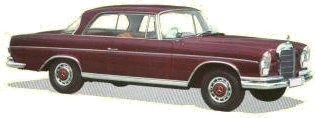 From March 1962, the
220SE models were joined by companion model 300SE Coupés and Convertibles, which bore the
W112 designation of their sedan equivalent. This is what designer Paul Bracq envisaged
when he designed his 300SE studies - a top-of-the-range luxury machine with the extra
attraction of high performance. The 300SE, of course, followed the example of its sedan
counterparts in featuring air suspension which supplied the car with a wonderful smooth
like handling. Automatic transmission was also standard. From March 1962, the
220SE models were joined by companion model 300SE Coupés and Convertibles, which bore the
W112 designation of their sedan equivalent. This is what designer Paul Bracq envisaged
when he designed his 300SE studies - a top-of-the-range luxury machine with the extra
attraction of high performance. The 300SE, of course, followed the example of its sedan
counterparts in featuring air suspension which supplied the car with a wonderful smooth
like handling. Automatic transmission was also standard.
|
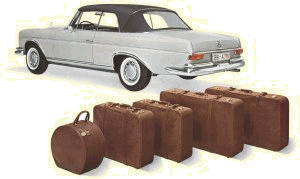 The 300SE was given a
power boost in 1964 to improve its performance. However, more far-reaching changes were
made in the autumn of the following year. The cars picked up the stronger new rear axle
designed for the W108 sedans, together with larger disc brakes. To accomodate the larger
discs, the 300SE received 14in wheels in place of the 13in types. Thus revised, the 300SE
continued in production until December 1967 when it and the 250SE were both replaced with
the new 280SE Coupés and Convertibles.. The 300SE was given a
power boost in 1964 to improve its performance. However, more far-reaching changes were
made in the autumn of the following year. The cars picked up the stronger new rear axle
designed for the W108 sedans, together with larger disc brakes. To accomodate the larger
discs, the 300SE received 14in wheels in place of the 13in types. Thus revised, the 300SE
continued in production until December 1967 when it and the 250SE were both replaced with
the new 280SE Coupés and Convertibles..
|

|
From the outside, the basis of the 300SE Coupé/Convertible
models were the 220SE Coupé/Convertible models. So for a detailed description of the
300SE, please read chapter 3) 1961: The 220SE Coupés and
Convertibles first. You can read the word "300SE" where it says
"220SE". Below are things mentioned were the 300SE models differ from the 220SE
models. |

|
 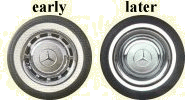 The early 300SE models had the same wheelcovers as the 220SE
models, rims with 12 holes and a detachable coloured hubcap in the middle. With the
arrival of the 250 SE Coupé/Convertible in 1965, Mercedes gave the wheels of the 300SE
models the same appearance as the wheels of the 250SE Coupés/Convertibles. The rims now
no longer had the 12 holes but consisted of a single strip of chrome. The hubcaps remained
unchanged. The early 300SE models had the same wheelcovers as the 220SE
models, rims with 12 holes and a detachable coloured hubcap in the middle. With the
arrival of the 250 SE Coupé/Convertible in 1965, Mercedes gave the wheels of the 300SE
models the same appearance as the wheels of the 250SE Coupés/Convertibles. The rims now
no longer had the 12 holes but consisted of a single strip of chrome. The hubcaps remained
unchanged.
|
 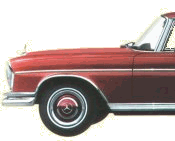 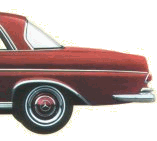 Mercedes
applied the same 'trick' with the 300SE Coupé/Convertible models as they did with the
300SE sedans when it came to distinguish these models from the other models: chrome and
lost of it! Mercedes
applied the same 'trick' with the 300SE Coupé/Convertible models as they did with the
300SE sedans when it came to distinguish these models from the other models: chrome and
lost of it!
Put into practise it ment that extra chrome was placed around the wheelarches and
alongside the side of the car.
|

|

|
Below are things mentioned where the 300SE Coupé/Convertible
models differ from the 220SE Coupé/Convertible models so for a more detailed description
of the interior of a 300SE, please read chapter 3) 1961: The 220SE
Coupé and Convertible first. You can read the word "300SE" where it says
"220SE".
|

|
The interior of the 300SE Coupés and Convertibles differed from
the cheaper models by the use of burr walnut rather than plain walnut, the 300SE models
incorporated 220km/h speedometers instead of 210 km/h types. The 300SE also featured a
courtesy light delay, which kept the interior light on for a few seconds after the doors
were closed. The gear-lever for the automatic transmission was still on the steering
colomn, later models had their gear-lever (automatic and manual) on the central tunnel.
Leather upholstery was standard on all Coupés and Convertibles. |